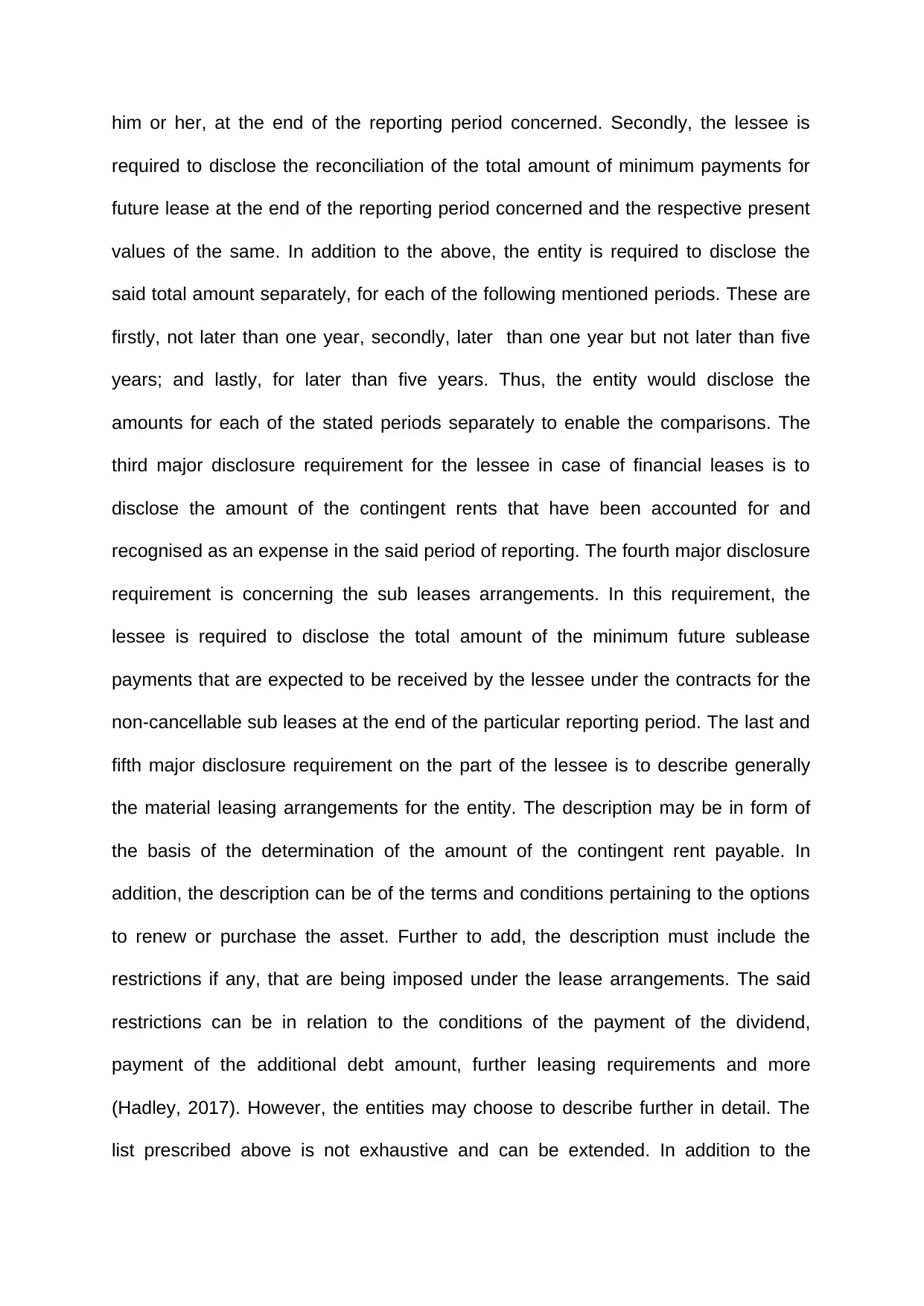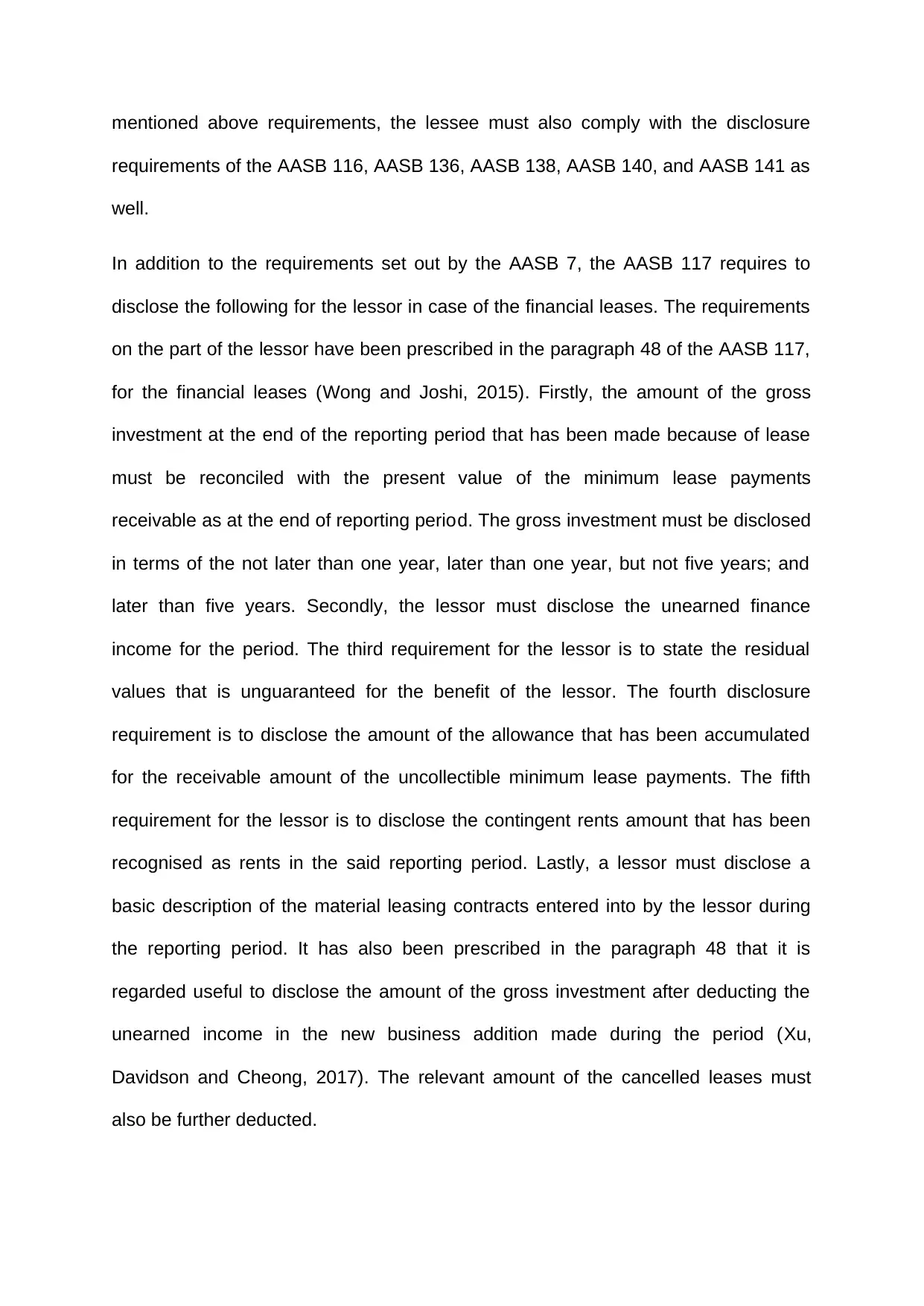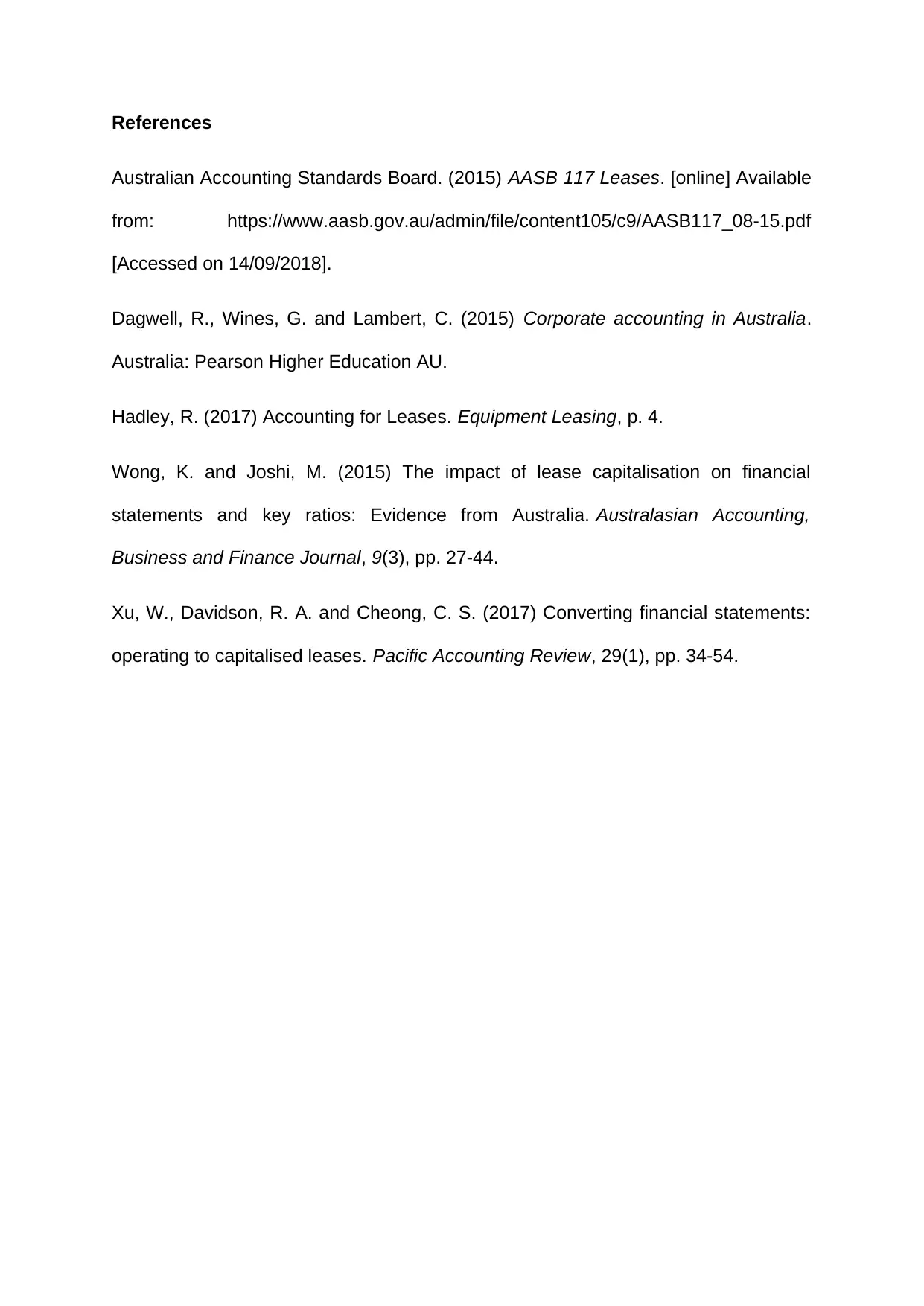Corporate Accounting: Finance Lease Disclosures, AASB 117 Analysis
VerifiedAdded on 2023/06/05
|5
|1226
|352
Report
AI Summary
This report provides a detailed analysis of finance lease disclosures as mandated by the Australian Accounting Standards Board (AASB) in AASB 117 Leases, within the context of corporate accounting. It defines financial leases, distinguishing them from operating leases, and outlines the specific disclosure requirements for both lessees and lessors. For lessees, the report highlights the need to disclose the carrying amount of leased assets, reconciliation of minimum lease payments, contingent rents, future sublease payments, and general material leasing arrangements. For lessors, it emphasizes the disclosure of gross investment reconciliation, unearned finance income, unguaranteed residual values, allowance for uncollectible payments, contingent rents, and a basic description of leasing contracts. The report references relevant accounting standards such as AASB 7, AASB 116, AASB 136, AASB 138, AASB 140, and AASB 141, along with scholarly articles to support the analysis and provide a comprehensive understanding of the topic. The report emphasizes the importance of these disclosures for financial transparency and compliance with Australian accounting regulations.

14 September 2018
Corporate Accounting and Reporting
PART A: Disclosures for finance leases
Corporate Accounting and Reporting
PART A: Disclosures for finance leases
Paraphrase This Document
Need a fresh take? Get an instant paraphrase of this document with our AI Paraphraser

The Australian Accounting Standards Board also referred to as AASB, has
prescribed the specific accounting treatment, recognition principle and the disclosure
requirements of the leases in the Accounting Standard AASB 117 Leases (AASB,
2015). The section 334 of the Corporations Act 2001 prescribes the application of
the accounting standards as explained under.
According to the definition stated in the paragraph 4 of the AASB 117, a financial
lease has been described as the lease where the title of an asset may or may not be
ultimately transferred to the lessee, but it involves transferring of majorly all the risks
and rewards that are incidental part to the ownership of an asset. Thus, in simple
words it refers to an arrangement where the financing entity is the legal owner of the
asset, for the duration of the asset. However, the lessee has to share the economic
risks involved and returns arising out of the variations in the value of the asset. In
addition, the lessee has the operating control over the asset.
The financial assets have to fulfil the requirements with respect to the disclosure in
accordance with the AASB 138, AASB 116, AASB 136, AASB 140, and AASB 141,
together with the specific disclosure requirements contained in the AASB 117
(Dagwell, Wines and Lambert, 2015). The disclosure requirements of the financial
leases as prescribed in the AASB 117 have been described in the following
segment.
According to the AASB 117, the lessee is required to comply with the requirements
of the AASB 7 Financial Instruments: Disclosures, for the financial assets as
described here under. The requirements to disclose on the part of the lessee have
been prescribed in the paragraph 31 of the AASB 117 (AASB, 2015). Firstly, the
lessee has to report the carrying amount for each of the class of asset, possessed by
prescribed the specific accounting treatment, recognition principle and the disclosure
requirements of the leases in the Accounting Standard AASB 117 Leases (AASB,
2015). The section 334 of the Corporations Act 2001 prescribes the application of
the accounting standards as explained under.
According to the definition stated in the paragraph 4 of the AASB 117, a financial
lease has been described as the lease where the title of an asset may or may not be
ultimately transferred to the lessee, but it involves transferring of majorly all the risks
and rewards that are incidental part to the ownership of an asset. Thus, in simple
words it refers to an arrangement where the financing entity is the legal owner of the
asset, for the duration of the asset. However, the lessee has to share the economic
risks involved and returns arising out of the variations in the value of the asset. In
addition, the lessee has the operating control over the asset.
The financial assets have to fulfil the requirements with respect to the disclosure in
accordance with the AASB 138, AASB 116, AASB 136, AASB 140, and AASB 141,
together with the specific disclosure requirements contained in the AASB 117
(Dagwell, Wines and Lambert, 2015). The disclosure requirements of the financial
leases as prescribed in the AASB 117 have been described in the following
segment.
According to the AASB 117, the lessee is required to comply with the requirements
of the AASB 7 Financial Instruments: Disclosures, for the financial assets as
described here under. The requirements to disclose on the part of the lessee have
been prescribed in the paragraph 31 of the AASB 117 (AASB, 2015). Firstly, the
lessee has to report the carrying amount for each of the class of asset, possessed by

him or her, at the end of the reporting period concerned. Secondly, the lessee is
required to disclose the reconciliation of the total amount of minimum payments for
future lease at the end of the reporting period concerned and the respective present
values of the same. In addition to the above, the entity is required to disclose the
said total amount separately, for each of the following mentioned periods. These are
firstly, not later than one year, secondly, later than one year but not later than five
years; and lastly, for later than five years. Thus, the entity would disclose the
amounts for each of the stated periods separately to enable the comparisons. The
third major disclosure requirement for the lessee in case of financial leases is to
disclose the amount of the contingent rents that have been accounted for and
recognised as an expense in the said period of reporting. The fourth major disclosure
requirement is concerning the sub leases arrangements. In this requirement, the
lessee is required to disclose the total amount of the minimum future sublease
payments that are expected to be received by the lessee under the contracts for the
non-cancellable sub leases at the end of the particular reporting period. The last and
fifth major disclosure requirement on the part of the lessee is to describe generally
the material leasing arrangements for the entity. The description may be in form of
the basis of the determination of the amount of the contingent rent payable. In
addition, the description can be of the terms and conditions pertaining to the options
to renew or purchase the asset. Further to add, the description must include the
restrictions if any, that are being imposed under the lease arrangements. The said
restrictions can be in relation to the conditions of the payment of the dividend,
payment of the additional debt amount, further leasing requirements and more
(Hadley, 2017). However, the entities may choose to describe further in detail. The
list prescribed above is not exhaustive and can be extended. In addition to the
required to disclose the reconciliation of the total amount of minimum payments for
future lease at the end of the reporting period concerned and the respective present
values of the same. In addition to the above, the entity is required to disclose the
said total amount separately, for each of the following mentioned periods. These are
firstly, not later than one year, secondly, later than one year but not later than five
years; and lastly, for later than five years. Thus, the entity would disclose the
amounts for each of the stated periods separately to enable the comparisons. The
third major disclosure requirement for the lessee in case of financial leases is to
disclose the amount of the contingent rents that have been accounted for and
recognised as an expense in the said period of reporting. The fourth major disclosure
requirement is concerning the sub leases arrangements. In this requirement, the
lessee is required to disclose the total amount of the minimum future sublease
payments that are expected to be received by the lessee under the contracts for the
non-cancellable sub leases at the end of the particular reporting period. The last and
fifth major disclosure requirement on the part of the lessee is to describe generally
the material leasing arrangements for the entity. The description may be in form of
the basis of the determination of the amount of the contingent rent payable. In
addition, the description can be of the terms and conditions pertaining to the options
to renew or purchase the asset. Further to add, the description must include the
restrictions if any, that are being imposed under the lease arrangements. The said
restrictions can be in relation to the conditions of the payment of the dividend,
payment of the additional debt amount, further leasing requirements and more
(Hadley, 2017). However, the entities may choose to describe further in detail. The
list prescribed above is not exhaustive and can be extended. In addition to the
⊘ This is a preview!⊘
Do you want full access?
Subscribe today to unlock all pages.

Trusted by 1+ million students worldwide

mentioned above requirements, the lessee must also comply with the disclosure
requirements of the AASB 116, AASB 136, AASB 138, AASB 140, and AASB 141 as
well.
In addition to the requirements set out by the AASB 7, the AASB 117 requires to
disclose the following for the lessor in case of the financial leases. The requirements
on the part of the lessor have been prescribed in the paragraph 48 of the AASB 117,
for the financial leases (Wong and Joshi, 2015). Firstly, the amount of the gross
investment at the end of the reporting period that has been made because of lease
must be reconciled with the present value of the minimum lease payments
receivable as at the end of reporting period. The gross investment must be disclosed
in terms of the not later than one year, later than one year, but not five years; and
later than five years. Secondly, the lessor must disclose the unearned finance
income for the period. The third requirement for the lessor is to state the residual
values that is unguaranteed for the benefit of the lessor. The fourth disclosure
requirement is to disclose the amount of the allowance that has been accumulated
for the receivable amount of the uncollectible minimum lease payments. The fifth
requirement for the lessor is to disclose the contingent rents amount that has been
recognised as rents in the said reporting period. Lastly, a lessor must disclose a
basic description of the material leasing contracts entered into by the lessor during
the reporting period. It has also been prescribed in the paragraph 48 that it is
regarded useful to disclose the amount of the gross investment after deducting the
unearned income in the new business addition made during the period (Xu,
Davidson and Cheong, 2017). The relevant amount of the cancelled leases must
also be further deducted.
requirements of the AASB 116, AASB 136, AASB 138, AASB 140, and AASB 141 as
well.
In addition to the requirements set out by the AASB 7, the AASB 117 requires to
disclose the following for the lessor in case of the financial leases. The requirements
on the part of the lessor have been prescribed in the paragraph 48 of the AASB 117,
for the financial leases (Wong and Joshi, 2015). Firstly, the amount of the gross
investment at the end of the reporting period that has been made because of lease
must be reconciled with the present value of the minimum lease payments
receivable as at the end of reporting period. The gross investment must be disclosed
in terms of the not later than one year, later than one year, but not five years; and
later than five years. Secondly, the lessor must disclose the unearned finance
income for the period. The third requirement for the lessor is to state the residual
values that is unguaranteed for the benefit of the lessor. The fourth disclosure
requirement is to disclose the amount of the allowance that has been accumulated
for the receivable amount of the uncollectible minimum lease payments. The fifth
requirement for the lessor is to disclose the contingent rents amount that has been
recognised as rents in the said reporting period. Lastly, a lessor must disclose a
basic description of the material leasing contracts entered into by the lessor during
the reporting period. It has also been prescribed in the paragraph 48 that it is
regarded useful to disclose the amount of the gross investment after deducting the
unearned income in the new business addition made during the period (Xu,
Davidson and Cheong, 2017). The relevant amount of the cancelled leases must
also be further deducted.
Paraphrase This Document
Need a fresh take? Get an instant paraphrase of this document with our AI Paraphraser

References
Australian Accounting Standards Board. (2015) AASB 117 Leases. [online] Available
from: https://www.aasb.gov.au/admin/file/content105/c9/AASB117_08-15.pdf
[Accessed on 14/09/2018].
Dagwell, R., Wines, G. and Lambert, C. (2015) Corporate accounting in Australia.
Australia: Pearson Higher Education AU.
Hadley, R. (2017) Accounting for Leases. Equipment Leasing, p. 4.
Wong, K. and Joshi, M. (2015) The impact of lease capitalisation on financial
statements and key ratios: Evidence from Australia. Australasian Accounting,
Business and Finance Journal, 9(3), pp. 27-44.
Xu, W., Davidson, R. A. and Cheong, C. S. (2017) Converting financial statements:
operating to capitalised leases. Pacific Accounting Review, 29(1), pp. 34-54.
Australian Accounting Standards Board. (2015) AASB 117 Leases. [online] Available
from: https://www.aasb.gov.au/admin/file/content105/c9/AASB117_08-15.pdf
[Accessed on 14/09/2018].
Dagwell, R., Wines, G. and Lambert, C. (2015) Corporate accounting in Australia.
Australia: Pearson Higher Education AU.
Hadley, R. (2017) Accounting for Leases. Equipment Leasing, p. 4.
Wong, K. and Joshi, M. (2015) The impact of lease capitalisation on financial
statements and key ratios: Evidence from Australia. Australasian Accounting,
Business and Finance Journal, 9(3), pp. 27-44.
Xu, W., Davidson, R. A. and Cheong, C. S. (2017) Converting financial statements:
operating to capitalised leases. Pacific Accounting Review, 29(1), pp. 34-54.
1 out of 5
Related Documents
Your All-in-One AI-Powered Toolkit for Academic Success.
+13062052269
info@desklib.com
Available 24*7 on WhatsApp / Email
![[object Object]](/_next/static/media/star-bottom.7253800d.svg)
Unlock your academic potential
Copyright © 2020–2025 A2Z Services. All Rights Reserved. Developed and managed by ZUCOL.




